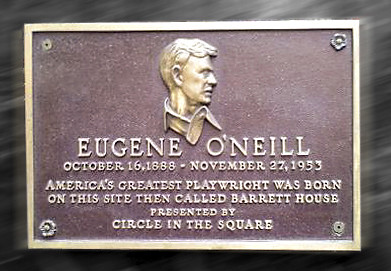Eugene Gladstone O’Neill was born in a hotel, the Barrett House, in New York City on October 16, 1888. His birth proved to be a prolonged and difficult ordeal for his mother, Mary Ellen who required morphine to endure the pain. Her resulting opioid addiction was something she struggled with for twenty-five more years. Born in Ireland, O’Neill’s father, James was an actor employed by traveling theater companies and best known for playing the leading role in the play The Count of Monte Cristo.
His father’s acting career required him to be on the road for much of the year, often accompanied by his wife and their young son. The thespian’s life on the road was not appropriate for a young boy and consequently, in 1895 when Eugene was seven years old he was sent to a boarding school, St Aloysius Academy for Boys in the Bronx. It was there that he resided and received his education for the next five years. Though separated from his parents and older brother for much of each year, the O’Neill’s always reunited every summer at the family’s seasonal seaside residence, a cottage known as Monte Cristo in New London, CT. This cottage and his family’s turbulent interpersonal dynamics later became the setting for some of Eugene O’Neill’s most critically acclaimed plays.
O’Neill entered Princeton University in 1906 but his bouts with deep depression led him to drop out after one year. He joined the Marine Transport Workers Union and spent the next three years working on various merchant marine vessels. In 1912 at the age of twenty-four he spent one year in a sanitarium recovering from tuberculosis. It was during his year of recuperation that O’Neill made a commitment to seriously pursue the craft of playwriting. While living in Greenwich Village and spending the summers in Provincetown on Cape Cod, O’Neill developed strong relationships with the theater communities in both locales and access to local venues for the staging of his early plays. He experienced almost immediate critical and public success with his early works. This reinforced his confidence to continue to explore some of the darker elements of the human experience as the predominant themes in his work.
On February 3, 1920 O’Neill’s first published theatrical production Beyond the Horizon appeared on Broadway at the Morosco Theatre. Hailed by the critics as perhaps the first genuine American tragedy written for the stage, the play went on to win the Pulitzer Prize. Just two years later he received a second Pulitzer prize for his play Anna Christie, followed by a third Pulitzer prize for Strange Interlude in 1928.
In 1930 the author Sinclair Lewis defined the impact of Eugene O’Neill on modern American culture. “He has done nothing much in the American drama save to transform it utterly in ten or twelve years from a false world of neat and competent trickery to a world of splendor, fear and greatness”.
In 1936 Eugene O’Neill was awarded the Nobel Prize for Literature. During the period of time between 1940 and 1943 he wrote four of his most autobiographical plays including Long Day’s Journey into Night for which he posthumously received an unprecedented fourth Pulitzer prize. He died in a hotel room in Boston on November 27, 1953.
To view images of Eugene O’Neill and posters from his plays visit the historical photographs on the Flickr page located on the Otis Library’s website.

